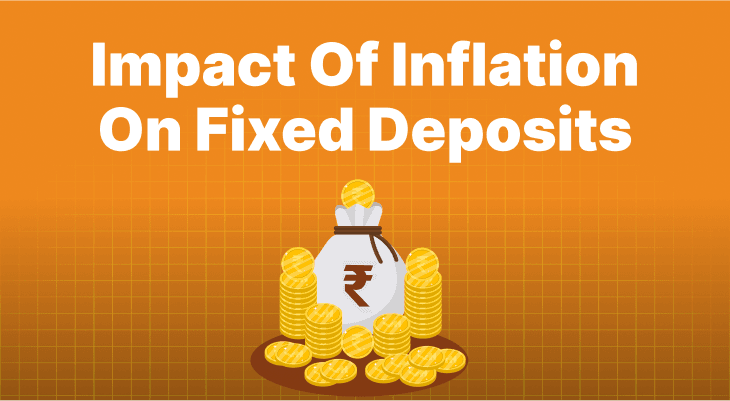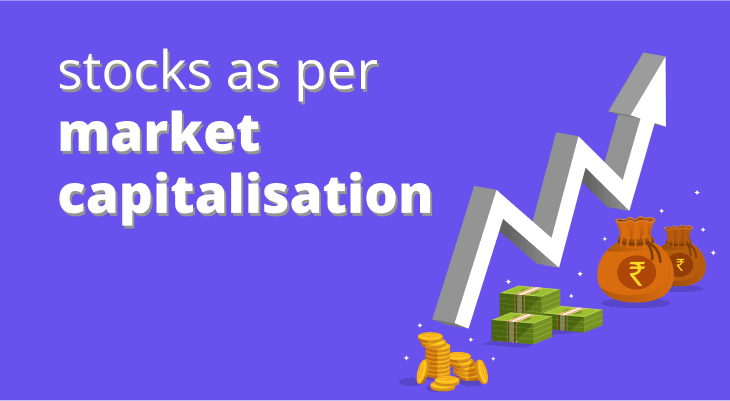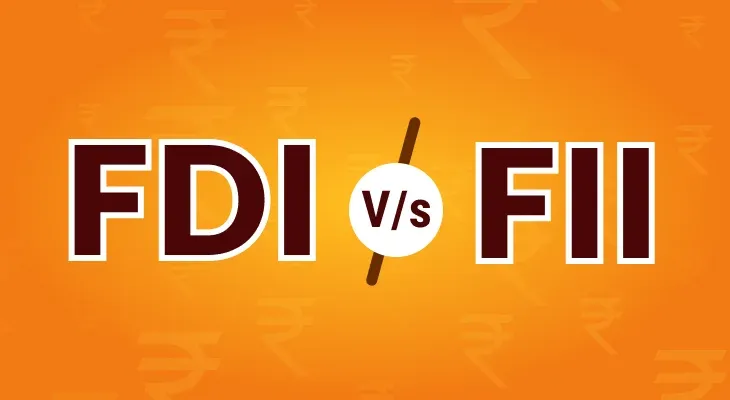
Table of content
- Understanding How Inflation Impacts FD Interest Rates
- Erosion of Purchasing Power
- Influence of Repo Rate Changes
- Impact on Long-Term FDs
- New Deposits vs. Existing Deposits
- Effect on Different Types of FDs
- Strategies to Enhance FD Returns
- Choose FDs with Higher Interest Rates
- Ladder Your FDs
- Utilise Senior Citizen Benefits
- Submit Form 15G or 15H
- Avoid Premature Withdrawals
- Invest in Tax-Saving Fixed Deposits
- Regularly Use an FD Calculator
- Investment Strategies for Inflationary Times
- Invest in Short-Term Deposits
- Diversify Your Investment Portfolio
- Opt for High-Income Generating Instruments
- Conclusion
Understanding The Impact Of Inflation On Fixed Deposits
Inflation is a key economic phenomenon that impacts everyone, from the daily wage earner to big organisations. It is defined by a consistent rise in the costs of goods and services over time, reducing the purchasing power of money. This indicates that the same amount of money will purchase fewer products and services than before. Fixed deposits (FDs) have traditionally been a popular choice among Indian investors due to their safety and consistency. However, inflation can have a major impact on these assets' returns. This blog aims to explain the impact of inflation on fixed deposits, as well as strategies for maximising returns despite inflationary pressures.
Understanding How Inflation Impacts FD Interest Rates
Let's look at how inflation impacts FD returns and what you can do to minimise its effects.
Erosion of Purchasing Power
Inflation instantly lowers the purchasing power of money. When prices for products and services rise, the value of your money falls. Your fixed deposit's real return is equal to the nominal interest rate adjusted for inflation. If the inflation rate rises, the actual value of the interest collected on your FD decreases. For example, if you get 6% interest on your FD and inflation is 4%, your real return is only 2%. This adjustment is crucial to understand since it accurately represents the profitability of your investment. A fixed deposit calculator allows you to simply calculate your real returns and see how inflation affects your investment.
Influence of Repo Rate Changes
The Reserve Bank of India (RBI) manages inflation through its monetary policies. One of the instruments it employs is the repo rate, which is the interest rate at which commercial banks borrow money from the central bank. When inflation rises, the RBI may raise the repo rate to manage it. This increases both lending and deposit interest rates. As a result, higher repo rates often translate into higher fixed deposit interest rates. However, current FD holders may miss out on the increased rates unless they reinvest their funds.
Impact on Long-Term FDs
High inflation can be especially damaging to people holding long-term fixed deposit accounts. If you locked in an FD at a lower interest rate, rising inflation might significantly decrease the value of your returns. Furthermore, due to inflation adjustments, new FDs may provide greater interest rates, while those with existing FDs may receive lower profits. Breaking your FD early to reinvest at better rates may result in penalties, which is another aspect to consider. Using an FD calculator will help you determine if it is advantageous to break your FD or not.
New Deposits vs. Existing Deposits
High inflation could cause the RBI to raise interest rates in order to control overspending and maintain economic stability. This position may be unfavourable for existing FD holders. New deposits may provide the highest fixed deposit interest rates, making older, lower-yielding deposits less appealing. Depositors holding long-term FDs may find themselves stuck with rates lower than the current market rate. If they withdraw their money before the maturity date, they could incur a penalty. This limitation might be challenging if they require funds to invest in higher-yielding alternatives.
Effect on Different Types of FDs
The effect of inflation on fixed deposits varies according to the type of FD. For example, regular FDs may suffer more during high inflation times than senior citizen FDs, which typically offer better interest rates. Understanding the consequences of inflation allows you to make informed investment decisions. Using a fixed deposit calculator allows you to analyse the possible returns of various types of FDs and make a sound decision.
Strategies to Enhance FD Returns
Here are a few strategies to assist you get the highest returns on your FDs:
Choose FDs with Higher Interest Rates
One of the most efficient strategies to increase your FD returns is to choose fixed deposit accounts with higher interest rates. Banks and non-banking financial companies (NBFCs) provide various fixed deposit interest rates. By comparing these rates with an FD calculator, you can determine the best fixed deposit interest rate. Opting for the highest rate will guarantee that you get the maximum return on your investment.
Ladder Your FDs
Laddering your FDs is a method for spreading your investment across many fixed deposits with varying maturity periods. Instead of investing in a single 5-year FD, consider dividing it into five FDs with maturities of 1, 2, 3, 4, and 5 years. This kind of approach has various advantages:
Regular Access To Funds
With various maturity dates, you may access a part of your savings on a regular basis without incurring early withdrawal penalties.
Reinvestment Opportunities
When each FD matures, you can reinvest the principal in a new FD at the current fixed deposit interest rate, which may be higher because of inflation on fixed deposits.
Risk Mitigation
Laddering helps to reduce the risk associated with locking all of your savings at a single interest rate.
Suppose you have ₹5,000.00 to invest in fixed deposits. Instead of investing it completely in a single 5-year FD, you can split it among many FDs of varying maturities:
1-year fixed deposit: ₹1,00,000 @ 7% interest.
2-year fixed deposit of ₹1,00,000 at 7.5% interest.
3-year fixed deposit: ₹1,00,000 at 8% interest.
4-year fixed deposit: ₹1,00,000 @ 8.5% interest.
5-year fixed deposit: ₹1,00,000 @ 6% interest.
After one year, reinvest the ₹1,00,000 from the matured 1-year FD at the current rate, say 7.2%. Repeat this process each year to take advantage of higher rates and adapt to market conditions.
Utilise Senior Citizen Benefits
Banks generally provide higher interest rates on fixed deposit accounts to older individuals. These rates are typically 0.25 to 0.50 percent higher than standard rates. If you or your parents are senior citizens, take advantage of the higher rates to maximise your earnings. Furthermore, several banks offer extra benefits like adjustable terms and periodic interest payments suitable for senior citizens.
Submit Form 15G or 15H
To avoid tax deduction at source (TDS) on your FD interest and maximise your returns, if you are in the non-taxable income category, send Form 15G or 15H to your bank. Form 15H is for those over 60, and Form 15G is for people below 60. By filing these forms, you may ensure that your FD interest is not subject to TDS, hence increasing your returns.
Avoid Premature Withdrawals
Withdrawing your FD before its maturity date might result in hefty penalties, often approximately 1% of the fixed deposit interest rate. This penalty may significantly limit your returns. To avoid this, manage your money properly and commit to allowing your FDs to mature. If you foresee the need to access your money, consider laddering your FDs to provide liquidity without prematurely closing the deposits.
Invest in Tax-Saving Fixed Deposits
Two benefits of tax-saving fixed deposits are their competitive interest rates and their exemption from taxes under the Income Tax Act Section 80C. There is a five-year lock-in period on these fixed deposits, during which the principal amount is not accessible. The tax deduction for the principal amount of these FDs may reduce your overall tax obligation even if the interest on them is taxable. Those who fall into higher tax brackets will particularly benefit from this strategy.
Regularly Use an FD Calculator
An FD calculator is an important instrument for managing your fixed deposit savings. It allows you to compare the various FD schemes and interest rates offered by banks and NBFCs. Using a fixed deposit calculator, you can calculate the possible returns on your investment and select the most suitable option based on your financial objectives and risk tolerance.
Investment Strategies for Inflationary Times
Adapting your investment plan during times of inflation is essential for protecting and growing your wealth. Here are a few strategies for survival during high inflation:
Invest in Short-Term Deposits
Short-term fixed deposits might be useful during inflationary circumstances. These deposits allow you to reinvest at possibly higher interest rates as they mature, maintaining your investment in line with the current economic conditions.
Diversify Your Investment Portfolio
Diversification is an important approach to reduce the effects of inflation. While fixed deposits provide stability, you should explore investing in other asset classes such as stocks, real estate, and inflation-protected instruments. Diversifying your portfolio can help you earn greater returns and spread risk.
Opt for High-Income Generating Instruments
Research and compare several fixed deposit options on the market. Look for instruments that offer significant returns, even during inflationary circumstances. Analysing past performance and current interest rates might help you pick the best FD alternatives.
Conclusion
Inflation has a substantial influence on fixed deposits, lowering their actual value over time. Understanding how inflation affects FD interest rates and using techniques to optimise returns might help you protect the funds you invest. By choosing higher interest rates, laddering your FDs, taking advantage of senior citizen benefits, and diversifying your portfolio, you can protect your savings from the adverse effects of inflation.
FAQ
How does inflation affect the purchasing power of money?
Inflation decreases the purchasing power of money over time. As prices rise due to inflation, the value of money declines, allowing you to purchase fewer products and services for the same amount of money.
Can fixed deposits protect against inflation?
Fixed deposits do not always provide a hedge against inflation since their interest rates may not keep up with growing inflation rates. Consider other investment options that provide better inflation protection.
Does fixed interest rate change with inflation?
No, the fixed interest rate on an FD remains the same throughout the term. However, if inflation results in the RBI's repo rate rising, new fixed deposits may provide higher interest rates.
Why do interest rates go up when inflation rises?
When inflation rises, interest rates often rise because the RBI may raise the repo rate to limit excessive spending and reduce inflationary pressures. Higher repo rates mean higher lending and deposit rates.
Is there a fixed deposit scheme intended specifically to counter inflation?
Currently, no fixed deposit plans are explicitly designed to combat inflation. However, you may look into alternative investing options, such as inflation-protected securities or equity investments, to help neutralise the effects of inflation.
What is the impact of breaking an FD prematurely during an inflationary period?
Breaking an FD early during an inflationary time may result in penalties and lower returns. It is best to avoid early withdrawals and allow your investment to mature to earn the maximum interest rate. If required, consider short-term deposits that meet your liquidity requirements.


